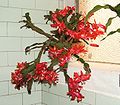Schlumbergera
| Schlumbergera subsp. var. | ||||||||||||||||||||||||||||||||||||||||||||||||||||||||
|---|---|---|---|---|---|---|---|---|---|---|---|---|---|---|---|---|---|---|---|---|---|---|---|---|---|---|---|---|---|---|---|---|---|---|---|---|---|---|---|---|---|---|---|---|---|---|---|---|---|---|---|---|---|---|---|---|

|
|
| ||||||||||||||||||||||||||||||||||||||||||||||||||||||
| ||||||||||||||||||||||||||||||||||||||||||||||||||||||||
Schlumbergera is a genus of tree-dwelling cactus from Brazil introduced to Europe by the Kew collector, Allan Cunningham (1791-1839), in about 1816. [1]
They are tropical rainforest epiphytes, growing on tree branches where, despite the high rainfall, water drains off quickly so that "dry" conditions prevail much of the time. Not surprisingly these cacti are quite different in appearance from that of their desert-dwelling cousins.
This genus contains the popular Schlumbergera truncata, also known as Thanksgiving Cactus, also known as Christmas Cactus, which may flower in white, pink, red or purple. The Easter Cactus or Whitsun cactus (Hatiora gaertneri) which produces vivid scarlet flowers belongs to Hatiora genus.
The stems of Schlumbergera resemble leaf like pads joined one to the other and the flowers appear from areoles at the tips. As might be deduced from the coloured flowers of this genus, they open during the daylight hours and close at night.
| Standard Cyclopedia of Horticulture |
|---|
|
Schlumbergera (named for Friedrich Schlumberger). Cactaceae. Similar to Zygocactus in habit, but with regular fls. and angled fr. Schumann referred some of the species to Phyllocactus (Epiphyllum), but such a reference can hardly be entertained. The genus seems to be confined to Brazil, but little is known about it in a wild condition. Its treatment should be the same as zygocactus (the old Epiphyllum). Two well-known species are in cult. CH
|
| Standard Cyclopedia of Horticulture |
|---|
|
syn. Epiphyllanthus (flower upon the leaf). Cactaceae. Epiphytic: sts. much branched, jointed, ribbed: areoles bearing setae instead of spines: fls. resembling those of Zygocactus; ovary angled.—One species known. Native of Brazil. For cult., see Succulents.
|
Cultivation
Propagation
It is very easy to clone these plants. Just a cutting with two leaves is enough. Bury the lower blade into some well drained cactae potting soil, press the soil with two fingers against the blade and after all the cuttings are in the pot, cover the pot with a tranparent plastic bag. The cuttings will root in 2 to 3 weeks in normal room temperature.
Pests and diseases
Species
- Schlumbergera kautskyi
- Schlumbergera gaertneri
- Schlumbergera microsphaerica
- Schlumbergera opuntioides
- Schlumbergera orssichiana
- Schlumbergera russelliana
- Schlumbergera truncata
- Schlumbergera × buckleyi
- Schlumbergera × exotica
- Schlumbergera × reginae
The following genera have been brought into synonymy with Schlumbergera:
- Epiphyllanthus A.Berger
- Epiphyllum Pfeiff.
- Opuntiopsis Knebel (nom. inval.)
- Zygocactus K.Schum.
- Zygocereus Fric & Kreuz. (orth. var.)
Gallery
References
- Standard Cyclopedia of Horticulture, by L. H. Bailey, MacMillan Co., 1963
External links
- w:Schlumbergera. Some of the material on this page may be from Wikipedia, under the Creative Commons license.
- Schlumbergera QR Code (Size 50, 100, 200, 500)


